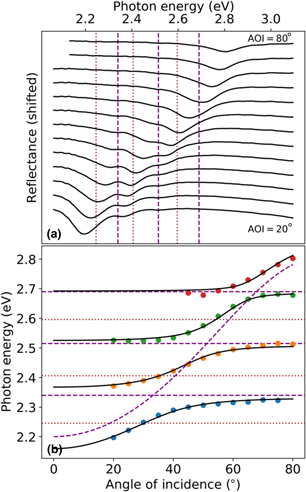Crossref Citations
This article has been cited by the following publications. This list is generated based on data provided by
Crossref.
Tanyi, E. K.
Van Schenck, J. D. B.
Giesbers, G.
Ostroverkhova, O.
and
Cheng, L.-J.
2020.
Controlling the Level of Coupling Between Quantum Emitters and Planar Hyperbolic Metamaterials.
p.
JW2D.26.
Van Schenck, J. D. B.
Mayonado, G.
Anthony, J. E.
Graham, M. W.
and
Ostroverkhova, O.
2020.
Molecular packing-dependent exciton dynamics in functionalized anthradithiophene derivatives: From solutions to crystals.
The Journal of Chemical Physics,
Vol. 153,
Issue. 16,
Puro, Richard
Van Schenck, Jonathan D. B.
Center, Reid
Holland, Emma K.
Anthony, John E.
and
Ostroverkhova, Oksana
2021.
Exciton Polariton-Enhanced Photodimerization of Functionalized Tetracene.
The Journal of Physical Chemistry C,
Vol. 125,
Issue. 49,
p.
27072.
Van Schenck, Jonathan D. B.
Goldthwaite, Winston T.
Puro, Richard
Anthony, John E.
and
Ostroverkhova, Oksana
2021.
Exciton Polaritons Reveal “Hidden” Populations in Functionalized Pentacene Films.
The Journal of Physical Chemistry C,
Vol. 125,
Issue. 49,
p.
27381.
Goldthwaite, Winston
Lamug, Roshell
Van Schenck, Jonathan
Puro, Richard
Anthony, John E.
Ostroverkhova, Oksana
Musser, Andrew J.
and
Baran, Derya
2022.
Photophysics and photochemistry of functionalized anthradithiophene in microcavities.
p.
11.
Ostroverkhova, Oksana
Goldthwaite, Winston
and
Lamug, Roshell
2024.
Excitons and polaritons in singlet fission materials: Photophysics, photochemistry, and optoelectronics.
MRS Bulletin,
Vol. 49,
Issue. 9,
p.
873.
Ullah, Ahasan
Lamug, Roshell
Zhang, Xueqiao
Ostroverkhova, Oksana
and
Cheng, Li‐Jing
2025.
Highly Sensitive and Fast‐Response Hybrid Phototransistors Enabled by Dynamic Photogating in Anthradithiophene‐Metal Oxide Heterojunctions.
Advanced Optical Materials,
Vol. 13,
Issue. 16,
